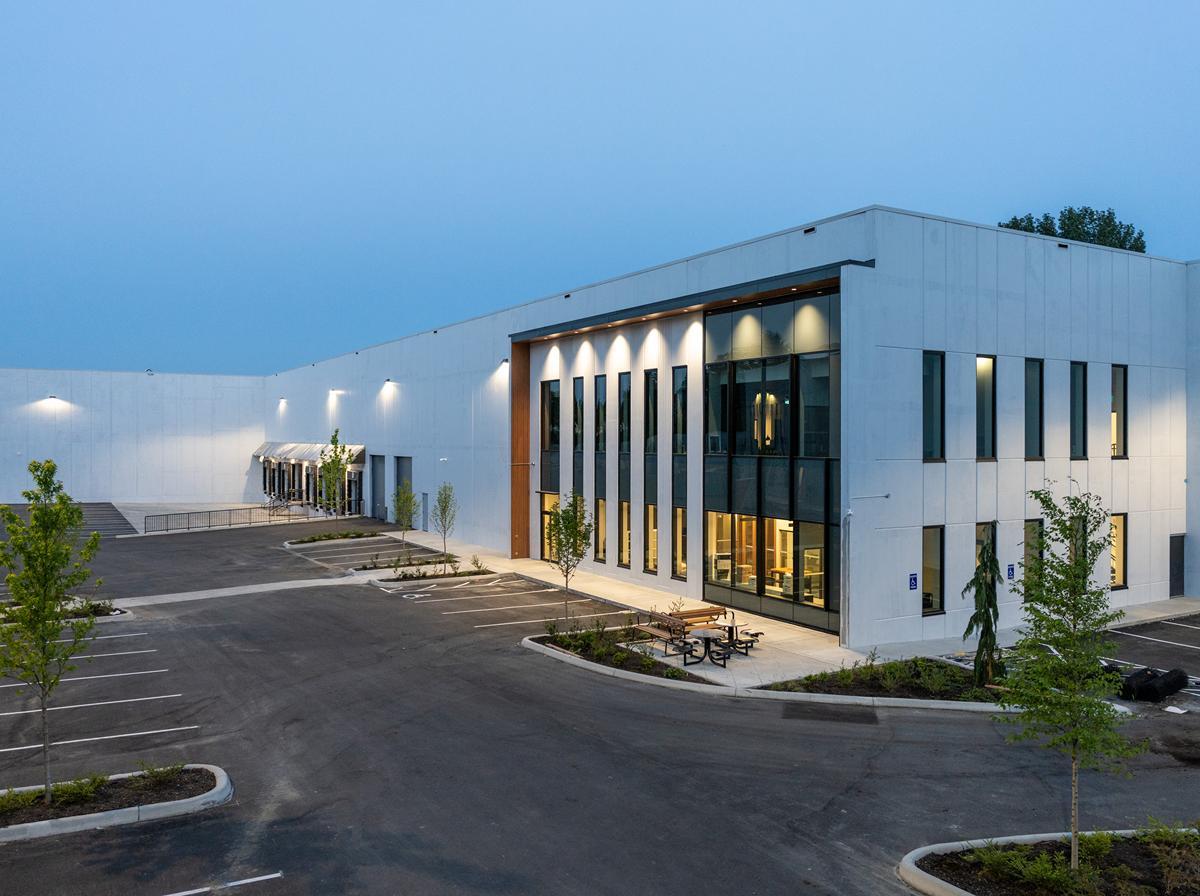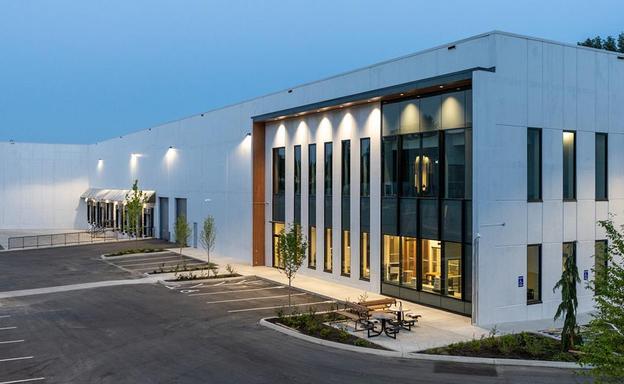Panorama Ridge Industrial
Summarize the project's program, features, and achievements: Designed to accommodate a variety of users, Panorama Ridge Industrial (“Panorama Ridge”) offered the opportunity to lease state-of-the-art industrial space in one of the fastest-growing commercial neighborhoods in Greater Vancouver, Colebrook. Comprised of 3 units that can be combined to accommodate a single user, Panorama Ridge is an ideal distribution hub offering immediate access to major transportation arteries connecting further into North America and across the Pacific. Faced with the challenge of Metro Vancouver’s limited land supply, the subject site required significant earthworks to prepare for construction, as Panorama Ridge was uniquely developed on a steep slope with a cross fall of 85 feet from north to south. Working in close collaboration with all consultants, the developer refined the building design to relocate parking from the surface to under the warehouse, allowing for an increase in site coverage which otherwise would have been heavily impacted by the many constraints of the property. Composed of 115 insulated concrete tilt-up panels, the facility totals 308,239 SF across three levels: 242,497 SF of warehousing, 9,532 SF of office, and a 56,210 SF semi-recessed parkade. While tilt-up buildings are typically constructed on a flat site, the parkade acts as the retaining and allowed for the construction of the primary building. Given the challenges of the site, a combination of both concrete tilt panels and IMP panels were used to meet the strict structural requirements of a distribution facility, while also designing around the suspended slab required for the parkade. Along the entirety of the north boundary, a significant shotcrete retaining wall was designed, in excess of 1000 feet in length and 40 feet in height at its maximum to allow for a second building to be constructed in the northwest corner of the property. Installation of the shotcrete wall was done concurrently with the parkade construction, which resulted in a detailed material management plan, extensive site coordination, and commitment with all trade partners to continue to advance these equally critical path items to deliver the facility on schedule to tenants. Due to both the parkade and shotcrete applications, the tilt-up methodology was modified to meet these unique conditions. Specifically, crane mobility was significantly limited due to the steep slope, retaining walls, suspended slab, and the Metro Vancouver South Surrey Interceptor Sewer that runs through the site. This 30-foot pressurized sewer main further constrained the property with both a geodetic elevation restriction and a weight restriction during construction and future operations. The project team had to create detailed work plans for all construction equipment, concrete trucks, and machinery to cross this key piece of infrastructure while pushing the overall project toward successful completion. Tilt-up construction played a key role in consolidating the construction timeline, providing design flexibility, and meeting structural requirements to successfully develop Panorama Ridge on a unique site. The collaboration of the City, consultant teams, and trade partners coalesced to establish Panorama Ridge as a Class A distribution facility now and into the future.
What obstacles were overcome related to the schedule, budget, program, specification, site, etc. on this project? Water and soil management were key elements in the planning of Panorama Ridge. Due to the sizable grade change through the property (85 feet ) and the significant amount of rainfall in the region, the weather had a severe impact on-site preparation and building construction. Most significantly, the project faced one of the largest storms in recent history, when the Province of British Columbia was hit was an ‘Atmospheric River’ in November 2021, causing devastating floods across Greater Vancouver. Facing the potential for major drainage issues and on-site flooding, Beedie, in collaboration with key trade partners, created a phased approach to control the flow of water as well as a detailed detention strategy to facilitate construction and manage water levels on site. These established mitigation measures were implemented when the project was struck by severe weather events, resulting in minimized downtime, protected site conditions, and reduced impact on the project budget and timeline, allowing Beedie to deliver the project to tenants on schedule. Furthermore, in a collaborative effort between Beedie and all project consultants, the unique grade of the site was used to implement an integrated stormwater management system. This system treated on-site stormwater, retained it under the parking areas, then released it gradually into a natural environmental area, which allowed the site to work cohesively with the sensitive surrounding area and regulate water leaving the site to replicate pre-development water flows. This specialized system was at the forefront of all design considerations, ensuring the protection of downstream conditions.
Please communicate any engineering complexities or unique features of the panel design for this project. ? The traditional tilt-up methodology was modified during the construction of Panorama Ridge to accommodate the unique requirements of both the parkade and shotcrete wall. This wall, which occupies the entire northern boundary of the site, exceeds the height of the building in some sections. This created challenges in panel design and required a multi-phase crane lift to reposition the panels, creating a vertical panel to accommodate the near-zero lot line condition. Detailed design, planning, and coordination with site crews and crane operators was crucial in ensuring the panels were safely installed. Along the entirety of the southern site boundary, crane activity was significantly restricted due to the steep slope, retaining walls, suspended slab, and the Metro Vancouver South Surrey Interceptor Sewer. This 30-foot (10m) wide pressurized sewer main constrained the property with both a geodetic elevation restriction and a weight restriction during construction, which included the size of crane that could cross this major piece of infrastructure. As a result, the structural engineer had to design the concrete tilt panels to ensure a larger, heavier crane was not required. The project team also created detailed work plans for all construction equipment, concrete trucks, and machinery to cross this key piece of infrastructure while pushing the overall project toward a successful completion.
What is the potential for this project's impact on the community and/or environment? The Subject Property has a unique history within the City of Surrey, where its historical uses include agriculture, gravel mining, a vineyard, a paintball field, and most recently, a site for recreational vehicle use. The combination of the previous uses resulted in a substantial impact to the property’s sensitive environmental area. With collaboration between the Environmental, Hydrological, Geotechnical, and Civil Consultant teams, a restoration plan was successfully implemented by the Project Team, which treated the 15.2-acre site for invasive species, cleaned and correctly disposed of debris, and planted native riparian species throughout the project’s landscaping. Panorama Ridge Industrial is strategically located within one of the most densely populated industrial labour force regions in Greater Vancouver. It is conveniently located in close proximity to a number of major transit routes, making its location attractive to employees with short and efficient commute times. Not only did the construction of Panorama Ridge create jobs for hundreds of workers, but a distribution facility of this size continues to support the community and the people who live there by generating countless jobs now and for years to come.

Project Location
Surrey, BC V3S 0L2
Canada
TILT-UP ACHIEVEMENT AWARD
The Tilt-Up Achievement Awards were established to honor projects that use site-cast tilt-up concrete to introduce new building types, advance industry technology and provide unique solutions to building programs. Winning entries illustrate the variety, beauty, and flexibility of tilt-up construction.
ACHIEVEMENT
2023
The world’s greatest tilt-up structures are featured by the TCA as Tilt-Up Achievement Award Winners. Learn more >
Project Images
Project Team (TCA Members)
- Developer/Owner:
- Beedie
- General Contractor:
- Concrete Contractor:
- Architect:
- Engineer:
- Weiler Smith Bowers Structural Engineers
- Suppliers:
- Photographer(s):
- Raef Grohne
Project Specifics
- Project Category:
- Distribution
- Building Types:
- Distribution Center
- Finishes:
- Concrete (Polished)
- Concrete (Raw/Sealed)
- Exterior insulation and finish system (EIFS)
- Paint (Flat)
- Features:
- Formliner
- Reveals
- Insulation:
- Sandwich Panel (Composite)
- Environmental:
- Number of Floors:
- 3
- Tilt-Up Wall Area:
- 39,145 sq ft (3,637 sq m)
- Total Floor Area:
- 308,239 sq ft (28,635 sq m)
- Project Footprint:
- 242,497 sq ft (22,528 sq m)
- Tallest Panel:
- 43 ft 5 in (13.23 m)
- Widest Panel:
- 28 ft 0 in (8.53 m)
- Largest Panel:
- 1,090 sq ft (101.3 sq m)
- Heaviest Panel:
- 121,174 lbs (54,964 kg)







